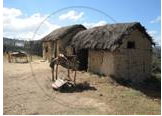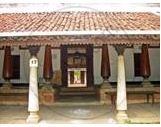Advertisements
Advertisements
प्रश्न
Collect photographs of typical rural houses and clothing of people from different regions of India. Examine whether they reflect any relationship with the climatic condition and relief of the area.
उत्तर
Housing:
Desert areas-

The climate in the deserts is extreme. The summers are very hot and dry. Sandstorms are common in this season. Water becomes scarce and in many places, there is a severe drought. Most places receive little or no rainfall.
North-eastern areas-

Northeast is not a single unit. It consists of 7 states with people belonging to diverse cultures, ethnic groups, and religions. A person living in Assam will have a very different lifestyle from an individual living in Manipur. Life in the cities and small towns is different from life in far-flung villages. However, there’s one characteristic in most Northeastern states that is common and that is simplicity.
South India:

Different states of South India have different cultures. Different states have their own festivals, dance forms, and food preferences. The climate, however, is similar in these states due to their close geographical proximity.
Clothing:
- You might find in Rajasthan, people wearing loose cotton clothes as day experiences real hot weather and night experiences real chilly weather, and people at nightwear warm clothes.
- In Jammu and Kashmir, people experience cold all time and so their dresses are designed likewise to avoid chillness.
- Chennai and places like Bangalore experience moderate climate so they wear cotton or synthetic clothes. (type of clothing style changes from season to season in these areas)
APPEARS IN
संबंधित प्रश्न
Choose the right answer from the alternative given below.
Monsoon arrives in India approximately in
There is a peculiar uniformity in the climate of India due to its unique ______.
Match the following.
| 1. | Rubber and Mahogany | Western Himalayas |
| 2. | Sandwood and rosewood | Eastern Himalayan Forest |
| 3. | Oak, birch, Silver | Coastal forest |
| 4. | Casurina, Palm and coconut | Deciduous forest |
| 5. | Sal, Semal, Jamun and Jujube | Evergreen forest |
Match the Column I with Column II.
| Column I | Column II | |
| A. | Tropical evergreen forest | Sandal wood |
| B. | Tropical Deciduous forest | Oak, silver fir |
| C. | Alpine forest | Black buck |
| D. | Tidal forest | Casuarina |
| E. | Coastal forest | Mahogany |
| F. | State animal of Andhra Pradesh, Pujab and Haryana | Mangrove trees |
The mighty ______ in the north play a vital role in influencing the climate of India.
What kind of Vegetation is supported by the sandy soil of the desert?
State whether right or wrong.
Temperature decreases from north to south in India.
Now think why Jodhpur has a hot desert type of climate?
In spite of these facts see carefully if there is strong evidence to conclude that the monsoons still provide a very strong framework lending overall climatic unity to the whole country.
Observe the following graph and answer the questions given below:

Note: In the graphs, the dark line represents the max. temperature and the lighter line represents min. temperature. The bars represent the amount of rainfall every month in each city.
- Where in the four cities is the rainfall heaviest?
- Which city has the most rainfall throughout the year?
- Which city experiences the highest temperature?
- Calculate the average range of minimum and maximum temperature for all four cities.
- What do the temperature curves in Delhi indicate?
- What is the condition of Mumbai during monsoons?
Observe the given figure and write the answers.
 |
- Which region gets more than 4000 mm of rainfall ?
- Identify the regions with maximum and minimum temperatures?
- In which direction is the temperature increasing?
- Identify the direction of the winds shown. What are they known as?
- Which winds are responsible for the rainfall in India ?
- Some part of Rajasthan is under desert? What could be the reason for it?
- Draw the main parallel of latitude passing through India which affects its climate.
- In which part of Peninsular India are semi- -arid climatic conditions found and why?
